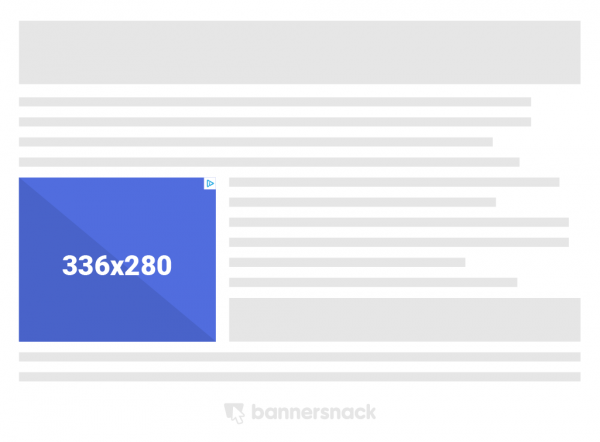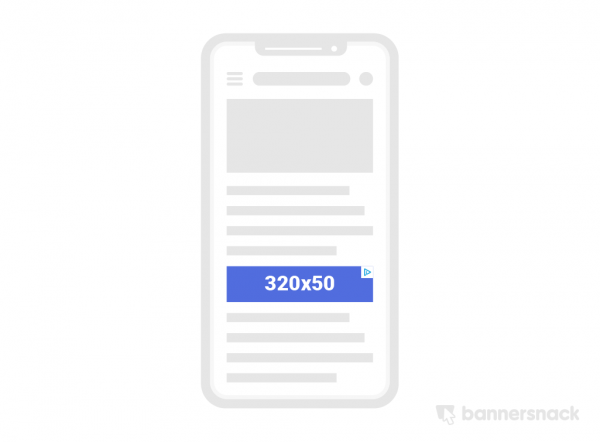When you’re doing online advertising, size matters.
And if you’re pouring money into Google ads, it’s critical to be aware of the banner ad sizes that generate the most amount of impressions, clicks, and sales.
Display ads are shown to users on websites that are not search engines.
They have the purpose of driving brand awareness by reaching a larger audience on different blogs, news sites, or niche websites. At the same time, they can also be used for remarketing purposes to improve conversions.
Google Ads come in different sizes which is it’s important to know how to optimize them properly to bring the best results.
Unfortunately, not having a correct understanding of banner ad sizes is one of the biggest mistakes made in online marketing.
It’s also one that could cost you a lot of money.
But it doesn’t have to be the case.
While using a banner maker can help in this respect, knowing how to properly optimize your ads can still be quite tricky, which is why we decided to write this article.
What are the most common and used standard banner ad sizes:
</tr align=”center”>
| 250 x 250 | Square | 150 KB |
| 200 x 200 | Small Square | 150 KB |
| 468 x 60 | Banner | 150 KB |
| 728 x 90 | Leaderboard | 150 KB |
| 300 x 250 | Inline Rectangle | 150 KB |
| 336 x 280 | Large Rectangle | 150 KB |
| 120 x 600 | Skyscraper | 150 KB |
| 160 x 600 | Wide Skyscraper | 150 KB |
| 300 x 600 | Half-Page Ad | 150 KB |
| 970 x 90 | Large Leaderboard | 150 KB |
Top Performing Banner Ad Sizes
| Dimension | Maximum size | |
|---|---|---|
| 300 x 250 | Medium rectangle | 150 KB |
| 336 x 280 | Large rectangle | 150 KB |
| 728 x 90 | Leaderboard | 150 KB |
| 300 x 600 | Half page or large skyscraper | 150 KB |
| 320 x 50 | Mobile leaderboard | 150 KB |
According to Google, these are the most common ad sizes that you should take into consideration. On top of that, we made a list for you that mentions the top performing banner ad sizes so check them out:
Medium rectangle (300×250 ad size)
This type of banner ad is the most compact one out of all these options so it doesn’t take up too much space on a web page. It performs well when it’s embedded within text content or when it’s placed at the end of an article. Because of the compact size, advertisers tend to favor it because it’s convenient to display. At the same time, it’s a good option when you’re just getting started with display ads.
Large rectangle (336×280 ad size)
Even though this banner ad size doesn’t get as many impressions as the first one, it’s still a popular option for advertisers. Since it’s similar to the medium rectangle, it performs best when it’s placed within text content or at the end of a post. Because it’s slightly bigger than the 300×250 ad size, it means that you will have more ad inventory.
Leaderboard (728×90 ad size)
This type of banner ad is called like this because it’s usually displayed noticeably at the top of a web page. If you want to get your ad in front of as many people as possible, then this is a good option to consider. Also, because you get more ad inventory, you can increase your earnings when text and image ads are enabled. Google advises using this banner ad size on forum sites.
Half page or large skyscraper (300×600 ad size)
Despite its name, the size of this type of banner ad does not cover half of a page. However, it does take up the most amount of space compared to the large banner sizes. This means that, as an advertiser, you have a lot more elbow room to get your message noticed. But this comes with the pressure of needing to create stunning visuals that draw people in and getting them to click on your banner ad.
Mobile leaderboard (320×50 ad size)
As you can tell from the name, this ad format is optimized for mobile devices. Even though it’s one of the smallest mobile banner sizes available, it should definitely be used as a way to maximize impressions and improve CTRs on mobile.
Related articles:
Display Advertising – The Ultimate Beginner’s Guide
Google Responsive Display Ads 101 – Everything You Need to Know
Why Google Ads Dimensions Are Important
The dimensions of display ads have been developed for different purposes and use cases.
Essentially, the size of a banner ad can impact how a user sees it, or even if they notice it.
Despite the fact that the differences in sizes are not that major, they can make a huge difference in proving their effectiveness.
In the end, your goal is not just for people to see your ad, but rather to get them to click on it and then convert the leads into customers.
This is where banner ad sizes come in handy.
As an advertiser, you want to pick the right banner size ad so you can maximize your campaign reach.
Luckily, we can give you a starting point in this article. This means that you will be able to focus on creating visuals that can bring you results.
However, keep in mind that a specific banner size doesn’t guarantee the success of an ad campaign but it’s definitely something to start with.
Conclusion
These top-performing sizes represent only the first stepping stone in banner ad creation.
The other aspects you should consider are:
- The copy you use on the banners;
- The colors;
- The CTA;
- The design.
To get started with display advertising, just consider these five sizes first and go from there. Do a few different A/B tests to figure out which size works best for the audience you’re targeting.
Let me know down in the comments which best practices you use when doing banner ad design.










abediasghar
December 28, 2018Gr8 an much wonderful article.. really it helped me alot!!!
Frank
February 14, 2019Thanks for sharing!
Riad Ahmed
March 7, 2019Thank you so much for sharing. If you give some size example. Thats really easy to understand the size.
Thank you.
Sockshare
May 15, 2019Its an amazing website, really enjoy your articles. Helpful and interesting too. Keep doing this in future. I will support you.
سئو
May 21, 2019Has a great charm
martin james
May 29, 2019my colleague used to tell me about this as i didn’t have much knowledge about banner placement and standard sizes of banners, and now i know how to use it, thanks for sharing this topic it helped me.
Robert Katai
May 30, 2019Happy we could help you!
cojones
June 11, 2019300×250 its a semisquare, graphic description is not accurate
Agence web Tunisie
June 21, 2019Nice article I agree with this
location de voiture en Tunisie
June 21, 2019Thanks for this article, so much information
Pranav
July 6, 2019I am using 1050 * 90
I think you need to update this post :-)
Gildas Niyigena
July 11, 2019Thanks for the article I am a designer, wanting to build some ads, and this did help me a lot.
Drone
August 21, 2019Thanks the above infographic really helped my website banner CTR go up
Myrond
September 7, 2019thanks, That was helpful
Nicole White
October 2, 2019Thank you. Much helpful!
Adrian Blackwell
October 10, 2019This was very useful. Thank for the article.
kazhan
October 27, 2019i want the Large Leaderboard – 970 x 90
Jim Knight
November 1, 2019very nicely explained and useful article. Thanx for sharing… it helps me a lot.
Ana Darstaru
November 1, 2019Happy to help!
Rob
December 23, 2019Is it common to use a ‘Leaderboard’ or ‘Large banner’ at the bottom of a page as a footer ad?
Does a mobile-friendly site automatically detect that it’s being viewed on a mobile device and serve a mobile ad instead of a non-mobile ad?
carolhensley
March 6, 2020Ana, appreciated to your work you are helping others in this way which is good for all of us and personally i appreciate your work and waiting for more this kind of posts from you in future.
Sam
March 20, 2020This is amazing, and a problem-solving website. Love this.
Keep it up!
pinku
March 29, 2020Thanks for telling the standard sizes of banner ads. I appreciate you for creating list of top 5 high performing ads size banner.
پروماد
May 8, 2020This was very useful. Thank for the article.
Ministry of Quotes
May 17, 2020It will be great if you can include various social media sizes.
Ana Darstaru
May 18, 2020Hi. You can find in this articlethis article the social media ad sizes. Hope this helps!
Mark Douglas
May 18, 2020I was looking for this. Thank you so much. It will help me so
Shahrose Khan
May 22, 2020hi Ana Darstaru i am from pakistan .I like yor blog pls guide me i am trying to make a blog and want to put ads in right places still not understanding how to put in layout .can you help me pls .your page is realy very nice
The Motivation Quotes
May 25, 2020Do you have sizes for various websites main sliders ? like what is ideal for Mobile , Tablet , Computer etc ?
Ana Darstaru
May 25, 2020Hi. I’m not sure what you mean by that. Could you please be more specific?
Ana Darstaru
May 25, 2020Hi. For mobile, the most common sizes are 300 x 250, 320 x 50, 320 x 100, 250 x 250, and 200 x 200. For desktop, 300 x 250, 336 x 280, 728 x 90, 300 x 600, 160 x 600, 970 x 90, 468 x 60, 250 x 250, and 200 x 200.
Ijeh Evans
June 3, 2020thanks girl you rock this article is the best of all bests thanks a lot !!
Fastlagos
June 5, 2020Interesting content. Was actually looking for Banner types to use for an advert when I say your website. Thanks for the Infographic.
ColourBangla
June 7, 2020I like this article. I have gained a lot of knowledge from your article. Thank you so much for displaying the information in your article.
Claridan TV
June 20, 2020Thanks a lot for this article, with this I was able to improve my site banners. At least now I understand banner sizes better.
The infographics helped a lot.
Amy
July 8, 2020Great article and visual presentation. My advertisers are usually familiar with 300×250 and those are top selling banner spaces on my blog. Amy
Schoolprojecttopics
August 15, 2020After going through this article, i decided to taste it on School Project platform and the results was very impressive. I basically like the 336×280 – Large rectangle
Projectstore
August 15, 2020This article is very educating.
George
August 25, 2020That was definitive, has helped me reduce ads size on https://georgeweb.org, continue with that
Bestcrawl
September 6, 2020Thanks for investing so much of your own time into knowledge-sharing and outreach, and especially thank you for choosing to write about this topic. Without doubt this blog is the source of knowledge.
Jonathan
September 18, 2020Nice article thank you from bannerpick
Moon Haze
November 25, 2020Great article. On my site, we use both 728 x 90 and 300 x 250. The 300 x 250 do consistently have a higher CTR. Thanks for sharing
Ayoola Daniel
November 28, 2020Thanks so much for this Banner Snack. I was looking for a banner size for my niche blog and I found this page. It is detailed and helpful. Thanks a lot!
Karan
December 2, 2020Hello Ana,
You shared very useful article, this is going to help in placing ads on my website.
Thanks a lot.
Vinit Vinayak
December 26, 2020your article is really useful.
Research Topics
December 26, 2020Thank you for sharing this article. i need to share this with my friends on social media
Salman
December 31, 2020Thanks for telling the standard sizes of banner ads. I appreciate you for creating list of top 5 high performing ads size banner.